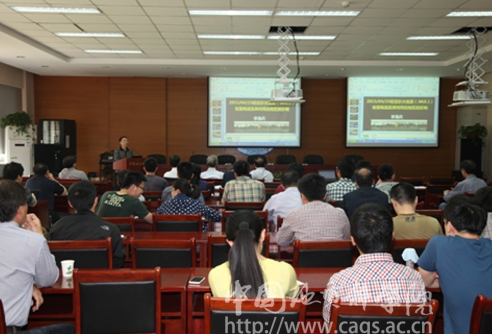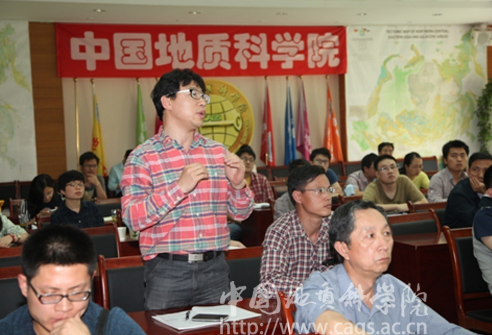Workshop on Nepal’s 8.1- magnitude Earthquake Held at CAGS
A workshop on the Nepal’s 8.1-magnitude earthquake was held at the Chinese Academy of Geological Sciences (CAGS) on April 29, 2015. “The workshop is held to commemorate those who lost their lives in the earthquake, send condolences to the people affected in this earthquake and explore the tectonic setting, mechanism and impact on the neighboring areas of this major earthquake.” said Prof. Wang Xiaolie, the Executive Vice President of CAGS.
Prof. Li Haibing from the Institute of Geology, CAGSdelivered a report entitled The Seismogenic Condition and Impact on Neighboring Areas of Nepal’s 8.1- magnitude Earthquake. The preliminary research suggests that this earthquake occurred as a result of the low-angle thurst of the Indian plate to the north, both the rupture and crustal stress extended eastward, and the co-seismic surface rupture zone might not appear.
The research team led by Prof. Peng Hua from the Institute of Geomechanics, CAGS, briefed on the real time monitoring of the crustal stress stations in China before and after this major earthquake. Monitoring data showed that the crustal stress significantly decreased right at the moment when the earthquake occurred, and the water level fell as well, but much later than the crustal stress did.
Prof. Wu Zhenhan, Vice President of CAGS, delivered a report entitled The Formation Mechanism and Disaster Effects of Nepal’s 8.1- magnitude Earthquake, which introduced the relation of the deep crustal structure to the earthquake and the potential secondary geological disasters caused by the earthquake. He suggested that the efforts should be intensified in the deep exploration research of the Himalayas and the Qinghai-Tibet Plateau and on the earthquake monitoring of the Himalayas and southern and eastern Tibet, so as to provide important basis for understanding the occurrence mechanism of strong earthquakes and doing a better job of disaster prevention and mitigation.
From the perspective of geophysics, Academician Chen Yuntai from Institute of Geophysics, Chinese Earthquake Administration discussed the focal mechanism, rupture process and comparison to the Wenchuan Earthquake of the Pokhara Earthquake in Nepal.
Prof. Dongshuwen, PI of SinoProbe, suggested CAGS organize an earthquake investigation team to Nepal to study scientific problems, help Nepal with disaster mitigation and prevention and post-disaster construction, and push forward the bilateral cooperation over the deep exploration research.
Since the occurrence of Wenchuan Earthquake in 2008, a group of CAGS scientists have been devoted to the research in the seismic tectonic and seismogenic mechanism, and initiated and implemented the Wenchuan Earthquake Scientific Drilling Project, which has yielded a series of important findings and research results. CAGS has established a reponse mechanism to organize workshops, seminars, field investigations or even research projects after the occurrence of major geo-hazards in China with a view to better tackling these geo-hazards from the geoscientific perspective. This Workshop is one of its kind.



